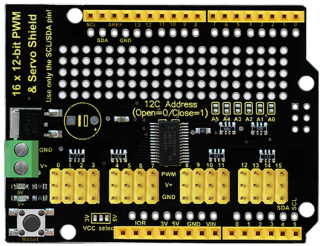Ks0258 keyestudio 16-channel Servo Motor Drive Shield: Difference between revisions
Jump to navigation
Jump to search
Keyestudio (talk | contribs) No edit summary |
Keyestudio (talk | contribs) No edit summary |
||
| Line 3: | Line 3: | ||
==Introduction== | ==Introduction== | ||
When we are doing robot experiments, it needs to use multiple PWM ports to drive the servo motor, however, the common used Arduino UNO R3 only has 6 PWM ports, so it is not enough.This allows you to use this expansion board, which is directly stacked on the Arduino UNO R3 board and can drive up to 16 servos. It uses I2C input, just occupies A4 and A5 of the Arduino UNO R3 board. The expansion board contains PCB double sided holes ,which can direct to solder with components to build up prototyping circuits. | |||
It | |||
==Specification== | ==Specification== | ||
* 1.I2C input, to control 16-channel PWM output | |||
* 2.Servo power supply independent V + input up to 6V | |||
* 3.Logic signal and logic power independent output 3-5v | |||
* 4.Frequency of 40-1000Hz | |||
* 5.Number of channels: 16-channel | |||
* 6.Resolution: 12-bit | |||
== Related Explanation of Interface == | |||
<br>[[File:KS0258.png|500px|frameless|thumb]]<br> | |||
== Wiring Method == | |||
==Resources == | ==Resources == | ||
Revision as of 14:08, 14 September 2017
keyestudio 16-channel Servo Motor Drive Shield
Introduction
When we are doing robot experiments, it needs to use multiple PWM ports to drive the servo motor, however, the common used Arduino UNO R3 only has 6 PWM ports, so it is not enough.This allows you to use this expansion board, which is directly stacked on the Arduino UNO R3 board and can drive up to 16 servos. It uses I2C input, just occupies A4 and A5 of the Arduino UNO R3 board. The expansion board contains PCB double sided holes ,which can direct to solder with components to build up prototyping circuits.
Specification
- 1.I2C input, to control 16-channel PWM output
- 2.Servo power supply independent V + input up to 6V
- 3.Logic signal and logic power independent output 3-5v
- 4.Frequency of 40-1000Hz
- 5.Number of channels: 16-channel
- 6.Resolution: 12-bit
Related Explanation of Interface
Wiring Method
Resources
Datasheet
PDF
